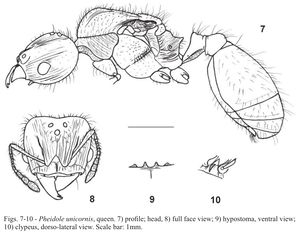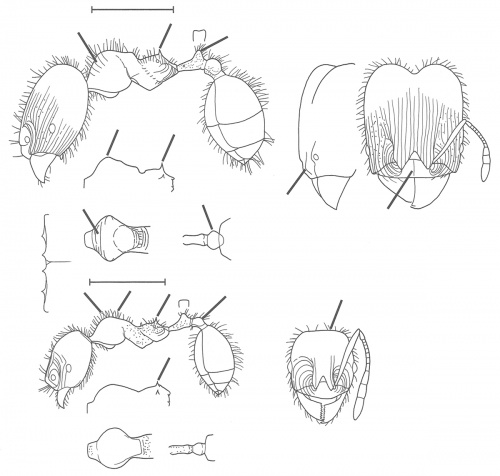Pheidole unicornis
| Pheidole unicornis | |
|---|---|
| Scientific classification | |
| Kingdom: | Animalia |
| Phylum: | Arthropoda |
| Class: | Insecta |
| Order: | Hymenoptera |
| Family: | Formicidae |
| Subfamily: | Myrmicinae |
| Tribe: | Attini |
| Genus: | Pheidole |
| Species: | P. unicornis |
| Binomial name | |
| Pheidole unicornis Wilson, 2003 | |
Occurs in mountain forests. Scupola (2012) collected specimens from a large polygynous nest located in the ground at the base of a banana plant (Otonga forest, Cotopaxi province, Ecudaor).
Identification
See the description in the nomenclature section.
Keys including this Species
Distribution
Known from the type locality, as well as Pichinde, also near Cali, at 1600 m; and near Cochancay, on Guayaquil-Tambo Highway, Cafiar, Ecuador. (Wilson 2003)
Latitudinal Distribution Pattern
Latitudinal Range: 3.437222° to -2.205842°.
| North Temperate |
North Subtropical |
Tropical | South Subtropical |
South Temperate |
- Source: AntMaps
Distribution based on Regional Taxon Lists
Neotropical Region: Colombia (type locality), Ecuador.
Distribution based on AntMaps
Distribution based on AntWeb specimens
Check data from AntWeb
Countries Occupied
| Number of countries occupied by this species based on AntWiki Regional Taxon Lists. In general, fewer countries occupied indicates a narrower range, while more countries indicates a more widespread species. |

|
Estimated Abundance
| Relative abundance based on number of AntMaps records per species (this species within the purple bar). Fewer records (to the left) indicates a less abundant/encountered species while more records (to the right) indicates more abundant/encountered species. |

|
Biology
Castes
Nomenclature
The following information is derived from Barry Bolton's Online Catalogue of the Ants of the World.
- unicornis. Pheidole unicornis Wilson, 2003: 772, figs. (s.w.) COLOMBIA.
Unless otherwise noted the text for the remainder of this section is reported from the publication that includes the original description.
Description
DIAGNOSIS Similar to Pheidole binasifera, Pheidole diabolus, Pheidole gravida, Pheidole mirabilis, Pheidole moseni, Pheidole nasifera, Pheidole rhinoceros and distinguished as follows.
Major: median carina of clypeus raised as a low, forward-projecting lobe; humerus in dorsal-oblique view a low lobe; mesonotal convexity suppressed; propodeal spines vertical on propodeal basal face, and in dorsal-oblique view curve slightly forward; dorsum of propodeum and anterior and lateral margins of pronotal dorsum carinulate; petiolar node in side view symmetrically rounded; postpetiole from above diamond-shaped.
Minor: occiput broad, lacking nuchal collar; posterior half of dorsal head surface smooth and shiny, and anterior half covered mostly by circular carinulae; propodeal spines vertical on propodeal dorsal face; postpetiolar node in side view suppressed; mesosomal pilosity consists of relatively short, erect bristles of nearly equal length.
MEASUREMENTS (mm) Holotype major: HW 1.42, HL 1.64, SL 0.72, EL 0.18, PW 0.84. Paratype minor: HW 0.72, HL 0.78, SL 0.64, EL 0.12, PW 0.46.
COLOR Major: head medium reddish brown, mandibles and body dark reddish brown; other appendages light reddish brown.
Minor: body medium reddish brown, appendages dark yellow.
Queen
Scupola (2012) - (n = 3) CL: (1.22-1.23); CW: (1.31-1.34); CI: (107-109); SL: (0.75-0.76); SI: (60-63); OL: (0.29-0.32); OI: (22-24); ML: (2.13-2.18); MH: (1.26-1.30); MW: (1.34-1.38); PL: (0.70-0.77); PH: (0.50-0.51); PW: (0.40-0.43); PI: (66-71); PPL: (0.38-0.42); PPH: (0.48-0.50); PPW:(0.64-0.67); PPI:(114-132); PPI2: (159-168).
Total length 6.3-6.4 mm. Head cordiform in full face view (Fig. 8), with anteriorly convergent sides and weakly concave posterior margin. Eyes located in front of the midlength of the head sides. Frontal carinae reaching the level of the posterior margins of the eyes. Clypeus with a strongly protruding, lobiform median carina (Fig. 10). Anterior clypeal margin sinuous, shallowly and widely notched in the middle. Hypostoma with two strong and protruding paramedian teeth and a pair of lateral teeth located on the inner margin (Fig. 9). Cephalic surface strongly longitudinally rugose, except the smooth sides, behind the level of the eyes, and the vertex. Scape short, not reaching the posterior margin of the head when laid back. Antennal pedicel longer than I+II+III funicular joints. Antennal club 3-jointed, elongate.
Mesosomal dorsum depressed. Pronotum transversely rugose; a small humeral gibbosity is present near the promesonotal suture. Scutum in dorsal view broad and mostly longitudinally rugose; its mid-anterior portion and the parapsides are smooth and shiny, the latters with sparse puncturation. Axilla with longitudinal
rugae; scutellum smooth. Anepisternum smooth and shiny, but punctate in the middle; katepisternum smooth and shiny. Propodeal sides longitudinally rugose. Propodeal teeth short and strong.
Petiole pedunculate, in profile with a triangular node, whose posterior face is weakly concave. Anterior face of the petiolar node weakly longitudinally rugulose; posterior face transversely rugulose; dorsum smooth. Petiolar sternite finely rugulose. Postpetiole in dorsal view trapezoidal with rounded sides. Postpetiolar sternite with a small protruding lobe. Gaster smooth.
Very long erect setae occur on the cephalic ventral surface, scutellum, dorsal surface of petiole and postpetiole, and are sparse on the gaster. Much shorter subdecumbent setae mostly abundant on the posterior margin of the head and on the scutum. A row of ordinary suberect setae is present near the base of anepisternum along the suture with the katespisternum.
Colour dark brown; legs, coxae, antennal funiculi and the space between the propodeal teeth testaceous. Wings fuscous with typical pheidoline venation (Bolton, 1982); veins and pterostigma brown.
Male
Scupola (2012) - (n = 3) CL: (0.59-0.61); CW: (0.51-0.59); CW2: (0.66-0.72); CI: (86-100); CI2: (97-112); SL: (0.21); SI: (34-36); SI2: (29-32); OL: (0.27-0.29); OI: (49-54); ML: (1.52-1.55); MH: (0.85-0.88); MW: (1.02-1.10); PL: (0.41-0.43); PH: (0.27-0.29); PPL: (0.21); PPH: (0.24-0.26); PPI: (114-124).
Total length 4.2-4.3 mm. Head small, rounded posteriorly in full face view. Vertex gibbous with well developed ocelli. Mandibles 5- or 6-toothed. Head finely longitudinally rugulose and with a silky glimmer. A median longitudinal strong ruga present on the frons, reaching the median ocellus. Compound eyes large, convex and protruding. Clypeus gibbous, transversally incised basally; and with fine transverse rugulae. Scape as long as the flagellar segments I + II. Pedicel globose. The remaining funicular joints thin. The last four joints gradually increasing in length.
Mesosoma with strongly convex scutum and scutellum. Notauli well marked. Scutum medially with a dense longitudinal rugulation, antero-medially unsculptured. Scutellum transversally rugulose, laterally finely longitudinally rugulose. Anepisternum anteriorly smooth, finely rugulose posteriorly; katepisternum finely rugulose. Propodeum angular in profile, but unarmed. Propodeal sides mostly rugulose; the rugulae encircling the spiracle. Legs long and thin, with elongate procoxae. Wing venation as in the queen.
Petiole, postpetiole and gaster smooth. Penicilli well developed. Aedeagus (Fig. 4) with large digitus (Fig. 5); sagitta rounded apically and with upper border serrated, bearing twelve denticles (Fig. 6).
Body with abundant long and flexuous standing setae, especially on ventral head surface, mesosternum, posterior gastral sternites, flexor surface of femora and posterior surface of meso- and metatibiae. Shorter setae occur on scutum, petiole and postpetiole, tibiae, tarsi and gastral tergites.
Head, scutum and scutellum dark brown, the remaining parts of the body dark testaceous. Scutum with a silky glitter. Legs testaceous with yellow tarsi. Penicilli and aedeagus yellow. Wings fuscous with brown veins and pterostigma.
Figure. Upper: holotype, major. Lower: paratype, minor. Scale bars = 1 mm.
Type Material
COLOMBIA: Television Tower Road, Salidito, near Cali, 2100 m, col. W. L. Brown and R. B. Root. Museum of Comparative Zoology
Etymology
L unicornis, one-horned, referring to the raised c1ypeal carina.
References
- Wilson, E. O. 2003. Pheidole in the New World: A dominant, hyperdiverse ant genus. Harvard University Press, Cambridge, MA. (page 772, fig. major, minor described)
- Heterick, B.E. 2021. A guide to the ants of Western Australia. Part I: Systematics. Records of the Western Australian Museum, Supplement 86, 1-245 (doi:10.18195/issn.0313-122x.86.2021.001-245).
- Heterick, B.E. 2022. A guide to the ants of Western Australia. Part II: Distribution and biology. Records of the Western Australian Museum, supplement 86: 247-510 (doi:10.18195/issn.0313-122x.86.2022.247-510).
- Scupola, Antonio. 2012. Descriptions of the male and queen of the north Andean ant Pheidole unicornis Wilson, 2003 (Hymenoptera: Formicidae). Atti della Società italiana di scienze naturali e del Museo civico di storia naturale di Milano. 153(II):203-210.
References based on Global Ant Biodiversity Informatics
- Fernández, F. and S. Sendoya. 2004. Lista de las hormigas neotropicales. Biota Colombiana Volume 5, Number 1.


